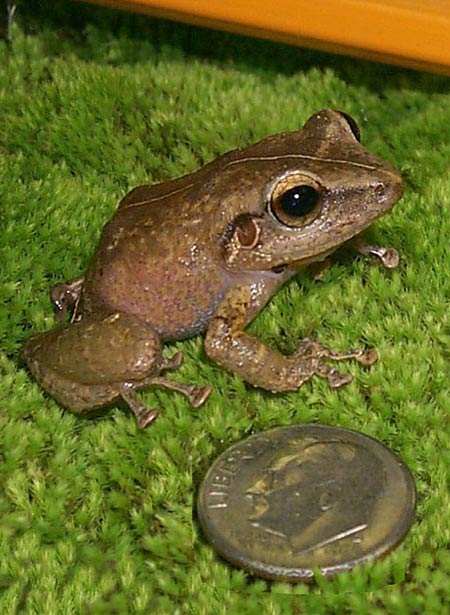(Eleutherodactylus coqui)
Order: Anura
All frogs in the order Anura are Hawaii State Injurious Species. It is prohibited to release Injurious Species into the wild; transport them to islands or locations within the State where they are not already established; or export outside the State.
Description:
- Small, nocturnal (night-active) frog about the size of a quarter, up to two inches in length
- Usually brown or gray-brown, may have a lighter stripe down its back
- Male’s mating call is a two-note, high-pitched “co-qui” (pronounced ko-kee)
- Native to Puerto Rico, accidentally introduced to Hawaii hidden in plants around or before 1988
Harm:
- No natural predators to keep populations in check (and no natural competitors), populations have reached 55,000 frogs per hectare in some Hawaii populations (24,000 frogs per hectare in Puerto Rico)
- Eat huge quantities of insects, removing insects from forest floor to treetops.
- Loss of insect services such as pollination
- Disrupt the balance of vulnerable native ecosystems
- Potential food source for snakes if they were to arrive
- Loud, incessant and annoying call from dusk until dawn
- Adverse economic impacts on tourism
- Decreased export plant sales
- Disclosure requirement for real estate transactions, has resulted in decreased property values in some locations
In Hawaii:
- Kauai – A breeding population of coqui covering about 10 acres was discovered in Lawai in 2001. After extensive efforts by KISC and partner agencies to eradicate coqui from Kauai, the island was declared officially coqui-free in June, 2012.
- Oahu – The only wild land population, located in Wahiawa, had over 100 calling frogs. Due to the efforts of HDOA, OISC, Oahu Army Natural Resources Program and DLNR, this population has been eradicated. Frogs are still found at nurseries and the owners are cooperating with the Oahu Coqui Frog Working Group.
On Oahu and think you hear coqui?
Call 643-PEST or click here for more information. - Maui – Thirteen populations in/around nurseries and hotels, residential areas and several large natural area populations. MISC has a full-time crew that spends a majority of their time clearing habitat and controlling coqui frogs within Maui’s populations.
On Maui and think you hear coqui? - Molokai – There are currently no populations of coqui on Molokai. MoMISC works to educate community members to aid in early detection, which succeeded in 2002 when a lone calling coqui was reported and subsequently captured by MoMISC.
For more information, see:
- Certified Coqui-Free Program from MISC
- Eleutherodactylus coqui information from HEAR
- Eleutherodactylus coqui information from ISSG
Tips for Maui Residents:
- Eliminate frog-friendly habitat
- Catch or spray your own coqui
- Citric mixing guidelines. This page has guidelines; be sure to follow all label directions.
- Build a CoquiBarrier
- Information on sprayers suitable for homeowner control of coqui frogs: Sprayer Info
- Report your coqui control efforts using Google Earth


